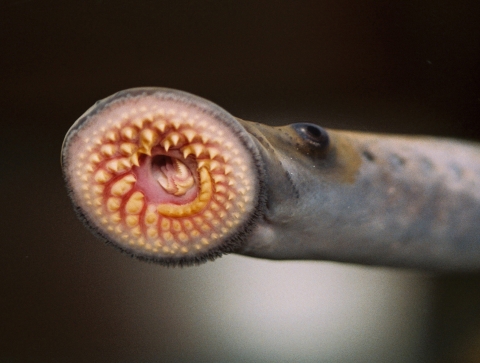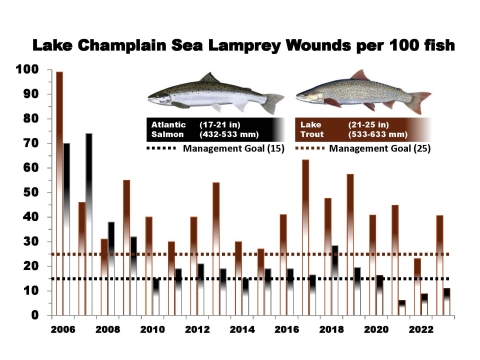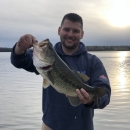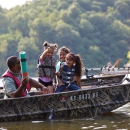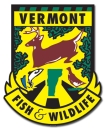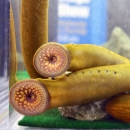States
New York, VermontLake Champlain Sea Lamprey Control Program: Protecting Lake Champlain, Restoring Native Species, Supporting Local Economies
Sea lamprey are jawless, parasitic fish native to the Atlantic Ocean that are believed to have entered Lake Champlain through shipping canals. Their preferred prey of cold-water, soft-scaled fish resulted in the decimation of native lake trout and landlocked Atlantic salmon, native fish populations of Lake Champlain already vulnerable from historic overfishing and habitat destruction. Since 1990, the Service has partnered with Vermont and New York to protect Lake Champlain by controlling this invasive species invasive species
An invasive species is any plant or animal that has spread or been introduced into a new area where they are, or could, cause harm to the environment, economy, or human, animal, or plant health. Their unwelcome presence can destroy ecosystems and cost millions of dollars.
Learn more about invasive species which has negatively impacted native fish populations and the Lake Champlain fishery.
Lake Champlain Sea Lamprey Control Program Overview
- Regions: Lake Champlain and tributaries in New York, Vermont, and Quebec
- Partners: Great Lakes Fishery Commission, New York Department of Environmental Conservation, Vermont Department of Fish and Wildlife
- Species Recovery: landlocked Atlantic salmon, lake trout, lake sturgeon
Restoring Native Species
Prior to the Service’s leadership in controlling sea lamprey in Lake Champlain, parasitic wounding rates were as high as 99 per 100 lake trout, 79 per 100 landlocked Atlantic salmon, and were impeding the recovery of lake sturgeon. Since working with our regional partners, wounding rates in these indicator species have decreased significantly, to a historic low below management goals for both species in 2022. Thanks to these efforts, lake trout are abundant and naturally reproducing, landlocked Atlantic salmon are returning to rivers, spawning and reproducing, and lake sturgeon are recovering.
Supporting Local Economies
Fishing is an important economic engine for local and regional communities. Sea lamprey control sustains a renewed and thriving recreational fishery. In addition to the improved population health anglers now enjoy on Lake Champlain, the public economic benefits of the program stand out - which are estimated at a $3.48 return for each $1 invested in the sea lamprey control program.
Economic Overview of Sea Lamprey Control
- $1.7 Million - Annual sea lamprey control costs for Lake Champlain.
- $5.9 Million - Economic gains from every $1.7 million spent on Lake Champlain sea lamprey control.
- $474 Million - Recreational fishing is restoring an economic engine to the local economy with an estimated $474 million dollars spent annually on fishing and other associated expenditures.
Controlling Sea Lamprey
Adult sea lamprey migrate into rivers and tributaries in the spring to spawn. The ammocetes remain in the river substrate as filter feeders for four years, then metamorphous into the parasitic form and return to the lake. To control the population, physical barriers are used to prevent the migration of adults to suitable spawning habitat and chemical lampricides are used to kill ammocetes before metamorphosis is complete. Together, these methods control sea lamprey reproduction and out-migration.
Monitoring is Key to Lampricide Application
Landlocked Atlantic salmon and lake trout populations are monitored annually to gauge program success, but sea lamprey ammocete populations are also monitored annually to determine where to focus lampricide control operations for the following year.
- 226 rivers are surveyed for ammocetes over a four-year cycle
- 25 rivers and deltas are chemically treated over a four-year cycle
Sea Lamprey Barriers Prevent Migration to Spawning Habitat
Low-head barrier dams with a sea lamprey trap installed capture adult sea lamprey as they migrate upriver to preferred spawning habitat. Biologists from the USFWS monitor these traps regularly during spawning season, moving native species upstream and logging species data to supply to regional partners.
- 9 rivers have a form of physical barrier installed
Gains Can Be Lost
It took decades to alleviate the impact of sea lamprey on the native species of Lake Champlain and, as a result, build a robust economy around the fishery. Without sustained sea lamprey control, native fish restoration successes will quickly succumb to sea lamprey parasitism and be lost, along with the social and economic benefits to local communities. Continued support of the Lake Champlain Sea Lamprey Control Program is foundational to the restoration gains made and is critical to sustaining the future of these native fish species in the region.
Assessment and treatment data are compiled into annual reports and available upon request.
Contact Steve Smith.
Sea Lamprey Control - Tentative Treatment Schedule and Advisory Updates
SEA LAMPREY CONTROL - FACT SHEETS
VIDEO - Wildlife Watch: The science behind eradicating sea lamprey
Sea Lamprey Control - NEPA Documents

